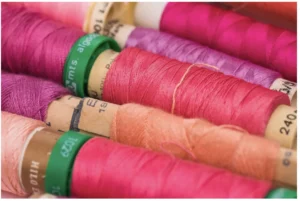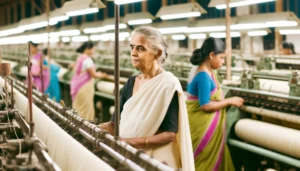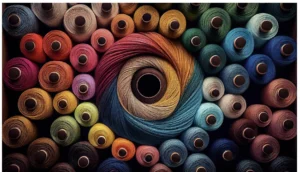The Role of India in Global Textile Manufacturing: Challenges and Advancements
India holds a prominent position in the global textile manufacturing industry, renowned for its rich heritage and diverse range of textile products. Despite its significance, the sector faces a myriad of challenges while also experiencing notable advancements. This blog aims to delve into the multifaceted landscape of India’s textile sector, exploring both its historical context and contemporary dynamics. Through this exploration, we will uncover the evolution of India’s textile industry, the impact of globalization and technological advancements, and the key challenges and advancements shaping its trajectory.

Historical Context of India’s Textile Industry:
The roots of India’s textile industry run deep, tracing back to ancient times when it was known for producing fine fabrics like muslin and silk. Over the years, the industry has undergone significant transformations, evolving from cottage-based handloom weaving to mechanized production during the British colonial era. The impact of globalization and technological advancements has further shaped the trajectory of India’s textile sector, influencing production methods, market dynamics, and trade relationships. Today, India’s textile industry stands as a testament to its rich heritage and resilience in adapting to changing times.
Current Status of India’s Textile Manufacturing:
India holds a significant position in the global textile market, renowned for its diverse range of textiles and clothing products. Its rich heritage, skilled workforce, and extensive supply chain infrastructure contribute to its competitiveness on the global stage.
However, India’s textile industry faces several challenges, including stiff competition from other countries such as China, Bangladesh, and Vietnam. Infrastructure limitations, including outdated machinery and inadequate transportation networks, hinder the industry’s efficiency and scalability. Additionally, environmental concerns, such as water pollution and excessive chemical usage, pose sustainability challenges for the sector.
Despite these challenges, India’s textile manufacturing sector has witnessed notable advancements and innovations in recent years. From adopting sustainable manufacturing practices to embracing digital technologies for production and supply chain management, the industry is gradually evolving to address contemporary demands and market trends.
Challenges in India’s Textile Manufacturing:
Infrastructural Challenges: Outdated machinery and inadequate transportation networks hamper the efficiency and productivity of India’s textile manufacturing sector. Modernizing infrastructure and investing in advanced technology are imperative to enhance competitiveness and meet growing market demands.
Environmental Sustainability Concerns: India’s textile industry is grappling with environmental sustainability challenges, including water pollution from dyeing and finishing processes, and excessive chemical usage in textile production. Implementing eco-friendly practices, adopting cleaner production techniques, and investing in wastewater treatment facilities are essential to mitigate environmental impacts and ensure long-term sustainability.
Labor Issues: Despite having a large pool of skilled and semi-skilled labor, India’s textile industry faces challenges related to skill shortages and working conditions. Addressing labor issues through skill development initiatives, ensuring fair wages and working conditions, and promoting industry-wide standards for occupational health and safety are crucial steps towards fostering a sustainable and ethical textile manufacturing ecosystem.
Advancements in India’s Textile Manufacturing:
Adoption of Technology: India’s textile manufacturing sector is embracing technological advancements such as automation, robotics, and digitalization to enhance efficiency, productivity, and product quality. Automated machinery and digital manufacturing processes streamline production workflows, minimize errors, and accelerate time-to-market, thereby improving competitiveness in the global market.
Emphasis on Sustainable Practices: With increasing awareness of environmental sustainability, India’s textile industry is prioritizing eco-friendly practices and sustainable materials. From utilizing organic and recycled fibers to implementing renewable energy sources and eco-friendly dyeing processes, the sector is aligning with global sustainability standards to reduce its ecological footprint and promote responsible production.
Innovation in Design and Product Development: To cater to evolving consumer preferences and market trends, India’s textile manufacturers are focusing on innovation in design and product development. From incorporating digital design tools and 3D printing technology to experimenting with novel fabrics and finishes, the industry is driving creativity and differentiation to stay competitive in a dynamic marketplace.

Government Initiatives and Policies:
Overview of Government Schemes: The Indian government has launched various schemes and policies to support the textile industry, including the Textile Upgradation Fund Scheme (TUFS), Technology Upgradation Fund Scheme (TUFS), and the National Textile Policy. These initiatives aim to provide financial incentives, infrastructure support, and skill development opportunities to enhance the competitiveness and sustainability of the textile sector.
Analysis of Effectiveness: While government initiatives have played a crucial role in promoting growth and development in the textile industry, there are challenges in implementation and effectiveness. Issues such as bureaucratic red tape, inadequate funding allocation, and policy inconsistencies need to be addressed to fully leverage the potential of government support for the textile sector.
Suggestions for Future Policy Directions: To further enhance India’s textile manufacturing sector, policymakers should focus on streamlining regulatory processes, increasing investment in infrastructure and technology, and fostering collaboration between industry stakeholders. Additionally, there is a need for comprehensive policies that address environmental sustainability, skill development, and market access to ensure long-term growth and competitiveness.
Role of India in the Global Textile Supply Chain:
Examination of India’s Position: India holds a significant position in the global textile supply chain, with a diverse range of products, from cotton textiles to garments, yarn, and fabrics. Its robust manufacturing capabilities, skilled workforce, and rich textile heritage make it a preferred destination for global brands and retailers seeking quality products and competitive pricing.
Opportunities and Challenges: While India has immense potential to further expand its presence in the international market, it faces challenges such as competition from low-cost manufacturing hubs, fluctuating raw material prices, and compliance with stringent quality and sustainability standards. However, opportunities lie in leveraging its strengths in innovation, design, and sustainability to differentiate its offerings and capture niche markets.

Future Outlook and Opportunities:
Projections for the Future: The future of India’s textile manufacturing industry looks promising, with continued growth expected in domestic and international markets. Rapid urbanization, rising disposable incomes, and changing consumer preferences for sustainable and ethically sourced products present opportunities for Indian textile manufacturers to innovate and diversify their offerings.
Emerging Trends and Opportunities: Emerging trends such as digitalization, smart textiles, and circular economy practices offer avenues for innovation and differentiation in India’s textile sector. Additionally, initiatives like the Make in India campaign and favorable government policies supporting the textile industry create an enabling environment for growth and investment.
Recommendations for Stakeholders: To capitalize on India’s potential in the global textile market, stakeholders should focus on enhancing competitiveness through technology adoption, skill development, and sustainability initiatives. Collaboration across the value chain, from raw material suppliers to manufacturers and retailers, can drive efficiency, quality, and sustainability, positioning India as a leading player in the global textile supply chain.
Conclusion:
The blog has highlighted India’s significance in the global textile supply chain, along with the challenges and opportunities for its textile manufacturing industry. It is essential for stakeholders to address challenges such as infrastructure constraints, environmental sustainability, and quality compliance to sustain growth and competitiveness.
Manufacture in India offers numerous benefits for US entrepreneurs looking to set up an apparel business. By leveraging India’s skilled workforce, competitive pricing, and robust manufacturing infrastructure, you can access a diverse range of high-quality products and services tailored to meet your business needs. Additionally, India’s strategic location, favorable business environment, and growing consumer market present lucrative opportunities for expansion and long-term success. Partnering with Indian manufacturers allows you to tap into a wealth of knowledge, experience, and resources to optimize your supply chain, enhance product quality, and drive innovation in the apparel industry. Reach out to us at contact@avenueconsumer.com for more valuable insights.
